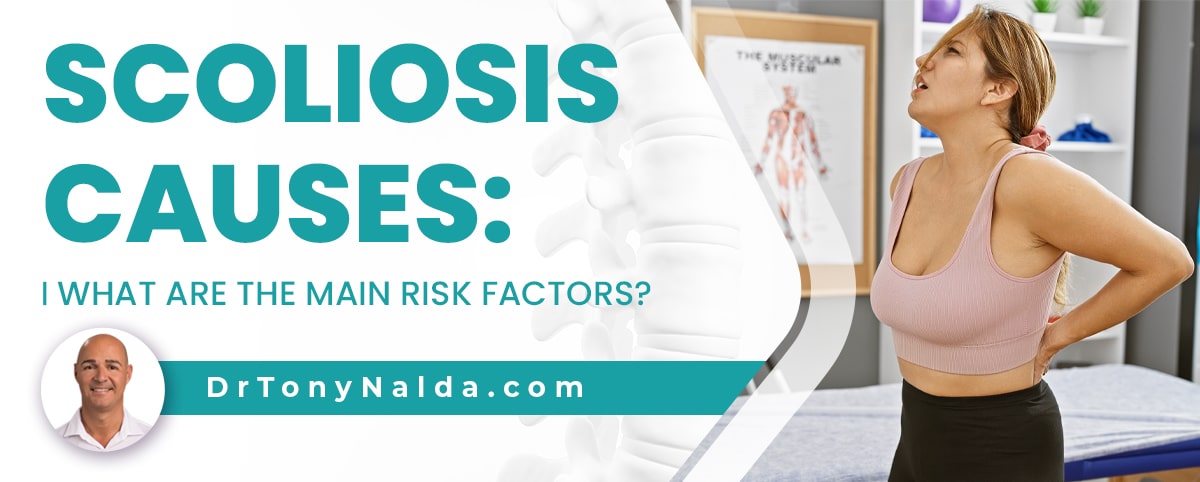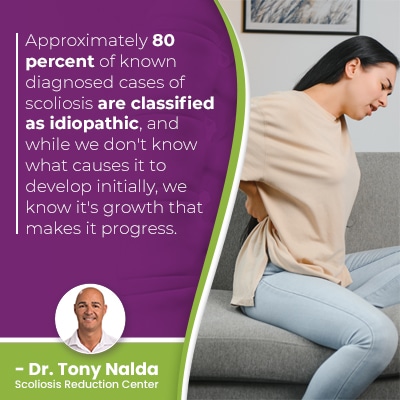Scoliosis Causes: What Are the Main Risk Factors?

Scoliosis causes vary based on the type of scoliosis in question. Different types have unique characteristics and treatment needs. While scoliosis isn't considered a genetic condition, having it in the family does increase the likelihood of someone else being diagnosed; continue reading to find out why.
Scoliosis doesn't just range widely in severity, there are also different types. Condition type is determined by causation, but the reality is that we don't know what causes most cases of scoliosis to develop. Having a family history of scoliosis is considered a risk factor.
Understanding scoliosis causation means understanding the difference between a genetic and familial condition.
Table of Contents
The Four Main Types of Scoliosis
There are four main types of scoliosis, and the most prevalent type is idiopathic scoliosis.
Idiopathic means not clearly associated with a single-known cause; idiopathic scoliosis is thought to be multifactorial (caused by a variety of factors that can differ person to person).
The most common type of scoliosis overall is adolescent idiopathic scoliosis, diagnosed between the ages of 10 and 18, and idiopathic scoliosis is also the most common type to affect adults.
Approximately 80 percent of known diagnosed cases of scoliosis are classified as idiopathic, and while we don't know what causes it to develop initially, we know it's growth that makes it progress.
 As a progressive condition, the nature of scoliosis is to get more severe over time, and this makes it more complex to treat, which is why being proactive with treatment can be so beneficial.
As a progressive condition, the nature of scoliosis is to get more severe over time, and this makes it more complex to treat, which is why being proactive with treatment can be so beneficial.
The spine gets increasingly rigid as scoliosis progresses, making the spine less responsive to treatment, and this is why starting treatment while conditions are still mild is associated with treatment success.
While there are never treatment guarantees, particularly with early detection and intervention, there are fewer limits to what can be achieved with treatment, and although progressive, scoliosis can be highly treatable.
As scoliosis is the leading spinal condition among school-aged children, a lot of research has been dedicated to gaining a better understanding of idiopathic scoliosis causation.
While having a family history of scoliosis is considered a risk factor, scoliosis isn't considered a genetic condition, and that's because scoliosis is more familial than genetic; let's explore what that means.
Is Idiopathic Scoliosis Genetic?
Idiopathic scoliosis is considered to be multifactorial, meaning caused by a number of factors, or a combination of factors, that can vary from patient to patient.
What's interesting is that if a patient has another family member diagnosed with scoliosis, this is considered a risk factor, a significant one.
Despite the amount of scoliosis research that's attempted to locate a specific gene, or genetic combination, that can account for the development of idiopathic scoliosis, it has yet to be identified; instead, the connection is understood as families sharing more than just their genes, a lot more.
Families can share similar body types, diets, lifestyles, socioeconomic factors, locations, responses to stress, postures, etc, and given the suggested multifactorial nature of scoliosis, it makes sense that any number of the aforementioned factors could play a role in the causation of idiopathic scoliosis.
There have also been twin studies done that show one twin having scoliosis and the other not, despite sharing the same genetics, or instances where one twin has one type of scoliosis, and the other has a completely different condition or curvature type.
The general consensus is that there could be some genetic factors that contribute to the development of idiopathic scoliosis but that the condition is considered more familial than genetic.
Outside of idiopathic scoliosis, the remaining 20 percent of known diagnosed cases are associated with known causes: neuromuscular, degenerative, and congenital.
Neuromuscular Scoliosis
The types of scoliosis with known causes are considered atypical and have some unique characteristics and treatment needs.
In cases of typical idiopathic cases, curves bend to the right, away from the heart, but in atypical cases,
Neuromuscular scoliosis patients are among the most severe scoliosis cases because the scoliosis is caused by a larger neuromuscular condition such as spina bifida, muscular dystrophy, or cerebral palsy, and the larger condition has to be the focus of treatment, complicating the process.
Neuromuscular conditions cause a disconnect between the brain and the muscles and/or connective tissues that support the spine; it's not just the spine that has to maintain its natural curves and alignment, but also the responsibility of the spine's surrounding muscles to provide spinal support and stability.
So neuromuscular scoliosis is caused by the presence of a neuromuscular condition.
Degenerative Scoliosis
Degenerative scoliosis affects older adults and is more common in females; this is due to changes in bone density and hormones related to menopause.
Degenerative scoliosis is caused by natural age-related spinal degeneration, and the cumulative effect of certain lifestyle factors can play a role in a person's level and rate of age-related changes in spinal health.
 Carrying excess weight, leading a sedentary lifestyle, chronic poor posture, smoking and or excessive alcohol consumption, and repeatedly lifting heavy objects incorrectly can strain the spine and weaken it over time.
Carrying excess weight, leading a sedentary lifestyle, chronic poor posture, smoking and or excessive alcohol consumption, and repeatedly lifting heavy objects incorrectly can strain the spine and weaken it over time.
Most spinal degeneration starts with the intervertebral discs; degenerative disc disease is a contributing factor in the development of a number of spinal conditions/issues.
A disc sits between adjacent vertebrae, providing cushioning, structure, flexibility, and acting as the spine's shock absorbers, and when a disc starts to degenerate, it can lose fluid, become desiccated, and changes shape as a result.
The vertebrae that are attached to the disc in between can be affected as the disc changes shape, and this can cause vertebral bodies to shift out of alignment with the rest of the spine and cause an unnatural spinal curve to develop.
As the spine is degenerating, it's more vulnerable to the development of a number of conditions, and degenerative scoliosis will make the spine increasingly unstable and unbalanced.
Degenerative scoliosis in older adults is caused by natural age-related spinal degeneration that commonly starts with the spinal discs.
Congenital scoliosis
Cases of congenital scoliosis are rare, affecting approximately 1 in 10,000.
Babies are born with congenital scoliosis that's caused by a malformed spine that develops in utero.
In some cases, the malformation can involve vertebral bodies failing to form into distinct and separate bones, instead forming into one solid bone and disrupting the spine's ability to form health curves.
In other instances, vertebrae can be misshapen and more triangular in shape than rectangular, as they should be, disrupting the spine's ability to form with the vertebrae stacked on top of one another in a straight and neutral alignment.
Babies born with congenital scoliosis often present with additional congenital abnormalities so need to be comprehensively assessed.
So scoliosis in babies is caused by a spine that is malformed in utero.
Conclusion
Scoliosis is a highly-prevalent and highly-variable spinal condition; no two cases are the same, and treatment plans need to be fully customized to address the specifics of a patient's condition and curvature type.
The first step to treating scoliosis is diagnosing scoliosis and further classifying conditions based on key variables: patient age, condition severity, curvature location, and type.
Condition type is determined by a condition's underlying cause, and in order to treat scoliosis effectively, its cause needs to be addressed.
But what about when the cause is unknown? This is the case with approximately 80 percent of scoliosis cases called idiopathic scoliosis, and while we don't know what causes idiopathic scoliosis to develop initially, we know it's growth that triggers its progression, and we know how to treat it effectively.
While it can be difficult to tell patients recently diagnosed that we don't know why they developed scoliosis, I point out that knowing the cause wouldn't necessarily change the course of treatment, or its outcome.
Scoliosis can be treated with surgical treatment (spinal fusion surgery) or non-surgical conservative treatment options, and the choice of one treatment approach over another can have far-reaching effects.
The most important decision to be made following a scoliosis diagnosis is how to treat it because this will shape the spine's long-term spinal health and function: an important factor for quality of life.
When the cause of scoliosis is known such as cases of neuromuscular scoliosis, degenerative scoliosis, or congenital scoliosis, the cause has to be the focus of treatment.
We know that idiopathic scoliosis has an underlying structural nature, so the focus of treatment is impacting the condition on a structural level in the form of a curvature reduction.
Here at the Scoliosis Reduction Center®, the first step to crafting an effective treatment plan is determining the type of scoliosis in question, and regardless of type or severity, as a progressive condition, the best time to start treatment is always now.
Dr. Tony Nalda
DOCTOR OF CHIROPRACTIC
After receiving an undergraduate degree in psychology and his Doctorate of Chiropractic from Life University, Dr. Nalda settled in Celebration, Florida and proceeded to build one of Central Florida’s most successful chiropractic clinics.
His experience with patients suffering from scoliosis, and the confusion and frustration they faced, led him to seek a specialty in scoliosis care. In 2006 he completed his Intensive Care Certification from CLEAR Institute, a leading scoliosis educational and certification center.
About Dr. Tony Nalda
 Ready to explore scoliosis treatment? Contact Us Now
Ready to explore scoliosis treatment? Contact Us Now





